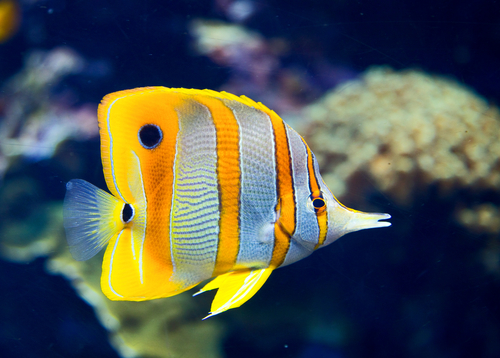Blog Categories

Will Copperband Butterfly Eat Aiptasia?
Absolutely, these fish are very good at Aiptasia control. They will generally leave if alone the first few days of being introduced to a new environment, but when they get comfortable they will start to drop down the aiptasia population.
Back to topMy Copperband Butterfly isn't eating aiptasia
There are several reasons why a Copperband Butterfly may not be eating the Aiptasia in your tank. These factors usually revolve around your Copperband being too stressed to have interest in eating the anemone.
Things you should consider about your fish are as follows.
-
Acclimation Stress: Copperband butterflyfish can be sensitive to changes in their environment. If recently introduced, they might be stressed from the transition, affecting their feeding behavior.
-
Dietary Transition: Copperbands might not immediately recognize Aiptasia as food, especially if they're not accustomed to it. Gradually transitioning them from their previous diet to Aiptasia can improve their acceptance.
-
Lack of Hunger: If the fish is well-fed with other foods, it might not be motivated to consume Aiptasia, especially if they're not hungry.
-
Aiptasia Quality: The size and health of Aiptasia matters. Copperbands might prefer smaller, healthier anemones, and avoid those that appear unhealthy or too large.
-
Other Food Sources: If your tank has plenty of alternative food sources, like copepods or bristle worms, the Copperband might prefer these over Aiptasia.
-
Tank Hierarchy: If there are other aggressive or dominant fish in the tank, they could prevent the Copperband from accessing the Aiptasia.
-
Stressors: Environmental factors like poor water quality, inadequate hiding spots, or excessive lighting can stress the fish and discourage feeding.
-
Individual Preference: Just like people, each Copperband has unique preferences. Some might readily eat Aiptasia, while others might not.
Pros and Cons of Adding a Copperband Butterfly To Your Aquarium
Pros of Adding a Copperband Butterfly to Your Aquarium:
-
Aiptasia Control: Copperband butterflyfish are effective natural predators of Aiptasia anemones, helping to keep their population in check without resorting to chemical treatments.
-
Visual Appeal: Copperbands are visually striking with their unique coloration and distinctive shape, adding beauty and diversity to your reef aquarium.
-
Invertebrate Diet: They have a natural diet that includes small invertebrates, making them useful for controlling other potential pests like bristle worms and small flatworms.
-
Peaceful Behavior: Generally peaceful and well-behaved, Copperbands are compatible with many reef tank inhabitants and won't pose threats to most corals and other fish.
-
Activity and Curiosity: Copperbands are active swimmers and can become interactive with their environment, offering entertaining behavior to observe.
Cons of Adding a Copperband Butterflyfish to Your Aquarium:
-
Dietary Challenges: Copperbands can be finicky eaters, often preferring live foods over prepared options. Ensuring a varied and suitable diet can be a challenge.
-
Coral Nipping (Potential): While not common, there's a slight possibility of Copperbands nipping at certain corals, especially those with extended polyps.
-
Compatibility: Some Copperbands can be territorial and may not tolerate others of their kind or similar-looking fish in the tank.
-
Acclimation Issues: These fish can be sensitive to changes in water quality and might experience stress during the acclimation period.
-
Availability and Cost: Obtaining healthy and well-acclimated Copperband butterflyfish can be challenging. They are often more expensive than other fish due to their popularity.
-
Longevity: Copperbands can be relatively short-lived compared to other marine fish, with an average lifespan of around 5-7 years.
-
Introduction to Aiptasia: While they're known to eat Aiptasia, Copperbands might not consume them immediately or consistently, potentially leaving some Aiptasia behind.
In Conclusion
In conclusion, the decision to add a Copperband butterflyfish to your aquarium comes with both pros and cons. On the positive side, Copperbands offer effective Aiptasia control, contribute visual beauty, and have a natural diet that can help manage other small invertebrate pests. They generally exhibit peaceful behavior and can be engaging to observeand are among the best fishes for eating aiptasia. However, challenges include their finicky eating habits, the potential for coral nipping (though rare), compatibility concerns, and the need for careful acclimation due to their sensitivity. While Copperbands can be valuable additions, success requires addressing their specific requirements and potential drawbacks. If you want to know more about the Copperband Butterfly you can read more about their profile here.
Back to topWhy are Aiptasia a problem in aquariums?
Aiptasia are invasive pest anemones that can multiply rapidly and sting other corals and tank inhabitants. They're tough to control and can harm the overall health of your reef or marine aquarium.
What should I feed my Copperband Butterflyfish if there are no Aiptasia left in my tank?
Copperband Butterflyfish have a varied diet. They can eat brine shrimp, mysis shrimp, finely chopped seafood, and even some high-quality frozen or prepared marine fish foods. Be sure to provide a balanced diet to keep them healthy.
How do I encourage my Copperband Butterflyfish to eat Aiptasia?
Sometimes, they need a little motivation to start eating Aiptasia. Try offering live Aiptasia or placing a bit of Aiptasia near their hiding spot. Once they discover it's food, they may start hunting for more.
Can I keep a them with other fish or corals?
They're generally peaceful but can be territorial with their own kind. Be cautious when housing them with aggressive tank mates or very similar species. They're usually reef-safe and won't bother corals.
What should I do if they refuse to eat Aiptasia?
Not all individuals have a taste for Aiptasia, and some may be picky eaters. If your fish isn't interested, consider other Aiptasia control methods, such as chemical treatments or manual removal.
Can I keep more than one of them in the same tank?
It's not advisable to keep multiple Copperband Butterflyfish in the same tank unless you have a very large setup with plenty of space and hiding spots. They can be territorial and may squabble.

